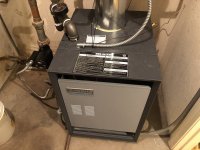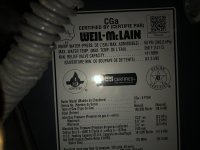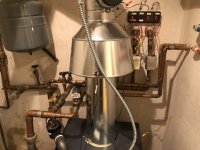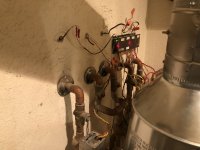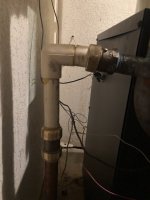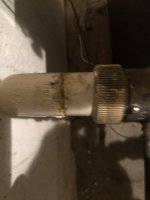Tim Fastle
Member
I had a leak in the heat exchanger in my old boiler (38 yo Burnham 165,000 BTU gas) and decided to have it replaced. I had an HVAC contractor do it and it was replaced with a 166,00 BTU Weil McClain boiler. A pretty similar boiler with some upgrades - ignitor, digital gauge and slightly smaller footprint. Based on information here I did run through the sizing calculations using my gas bills from the past and therms used in the coldest months and it sized out to be correct (1.4x).
SHORT VERSION
It now does not heat all the zones (8 zones, 4200 sf home) very well. The closer zones seem to work pretty well, the further zones much less so. He did not purge the system after the install and said that the air valve would take care of what little air may have gotten into it during the boiler exchange. Really, nothing else is really different, just a different boiler. I wonder if there might be air in the system and that is causing the circ pump to work inefficiently and not pump well. Short of just purging it, is there indicators or a way to tell if there is air in the system? I do not hear any heavy gurgling or anything abnormal. Before the exchange I did have some gurgling and none at all now. Clearly water is circulating because some areas heat decent but none as well as before. Or is there something else I should be considering. It goes through it's cycles just fine, up to 160 off, runs for a while, down to 140, back on. Below I will post more details in a long version but I suspect this will suffice in getting my point across. Thanks.
LONG VERSION
So it went in well, runs well, nice blue flame and seems to work fine. The only problem is that when a lot of zones (4200 sq. ft house, 8 zones total, 2 banks of 4 zones, one bank in the boiler room another in a closet in part of a 6 year old addition) call for heat it doesn't seem to be able to heat all of them. For instance, I am now in my office and the base board radiator unit isn't warm at all yet the furnace is heating, the circulation pump is running and the zone valve to my office (along with 5 others) is open. I am a little bamboozled. The HVAC guy seemed to know what he was doing and did a very clean installation. Since the layout of the new boiler was very similar to the old one it didn't require a great deal of new plumbing, really just a slight reroute of the pipes that connect the water to the distribution system. It seemed to work pretty well but it didn't seem like the baseboard units got quite as warm as before and some of the further out ones, in particular, the ones in the addition don't seem to work very well at all, especially when a lot of zones are calling. Before the exchange I never had this issue at all. They all heated up quickly and there was never a problem even if all zones were calling. The recirc pump is the same size (1/25 HP) and basically the same as the old one.
The only thing I can think of is that maybe there is air in the system and this is not allowing the pump to circulate the hot water effectively. I am fairly certain he did not purge the system at all after the install. He told me before hand he would not need to since our plumbing allowed him to isolate the boiler and there would be very little water loss. I don't hear a lot of gurgling (actually did have some of that before) or any indication of air in the system but I really don't know what those indications would be. Is this possibly my problem and how might I best figure it out?
Any input would be appreciated.
Thanks!
SHORT VERSION
It now does not heat all the zones (8 zones, 4200 sf home) very well. The closer zones seem to work pretty well, the further zones much less so. He did not purge the system after the install and said that the air valve would take care of what little air may have gotten into it during the boiler exchange. Really, nothing else is really different, just a different boiler. I wonder if there might be air in the system and that is causing the circ pump to work inefficiently and not pump well. Short of just purging it, is there indicators or a way to tell if there is air in the system? I do not hear any heavy gurgling or anything abnormal. Before the exchange I did have some gurgling and none at all now. Clearly water is circulating because some areas heat decent but none as well as before. Or is there something else I should be considering. It goes through it's cycles just fine, up to 160 off, runs for a while, down to 140, back on. Below I will post more details in a long version but I suspect this will suffice in getting my point across. Thanks.
LONG VERSION
So it went in well, runs well, nice blue flame and seems to work fine. The only problem is that when a lot of zones (4200 sq. ft house, 8 zones total, 2 banks of 4 zones, one bank in the boiler room another in a closet in part of a 6 year old addition) call for heat it doesn't seem to be able to heat all of them. For instance, I am now in my office and the base board radiator unit isn't warm at all yet the furnace is heating, the circulation pump is running and the zone valve to my office (along with 5 others) is open. I am a little bamboozled. The HVAC guy seemed to know what he was doing and did a very clean installation. Since the layout of the new boiler was very similar to the old one it didn't require a great deal of new plumbing, really just a slight reroute of the pipes that connect the water to the distribution system. It seemed to work pretty well but it didn't seem like the baseboard units got quite as warm as before and some of the further out ones, in particular, the ones in the addition don't seem to work very well at all, especially when a lot of zones are calling. Before the exchange I never had this issue at all. They all heated up quickly and there was never a problem even if all zones were calling. The recirc pump is the same size (1/25 HP) and basically the same as the old one.
The only thing I can think of is that maybe there is air in the system and this is not allowing the pump to circulate the hot water effectively. I am fairly certain he did not purge the system at all after the install. He told me before hand he would not need to since our plumbing allowed him to isolate the boiler and there would be very little water loss. I don't hear a lot of gurgling (actually did have some of that before) or any indication of air in the system but I really don't know what those indications would be. Is this possibly my problem and how might I best figure it out?
Any input would be appreciated.
Thanks!

